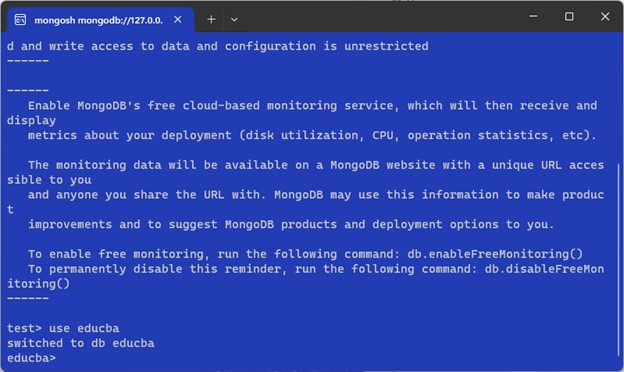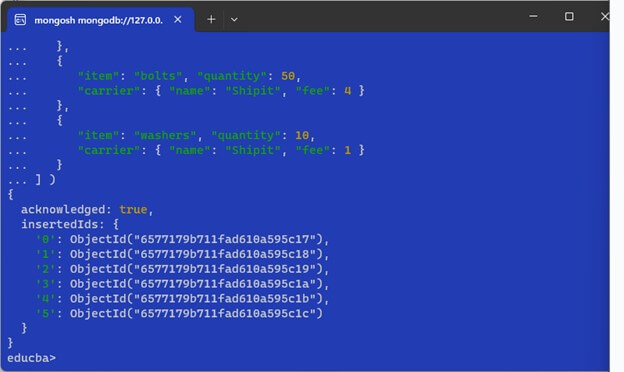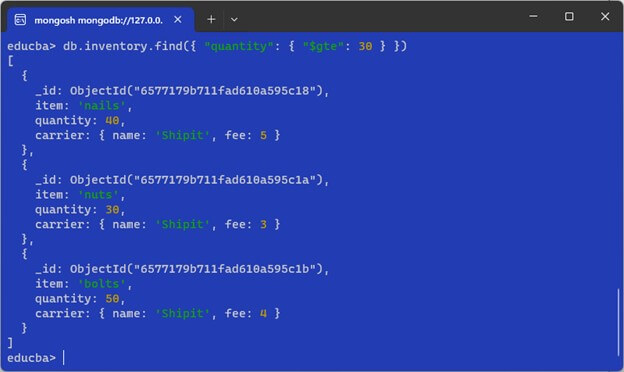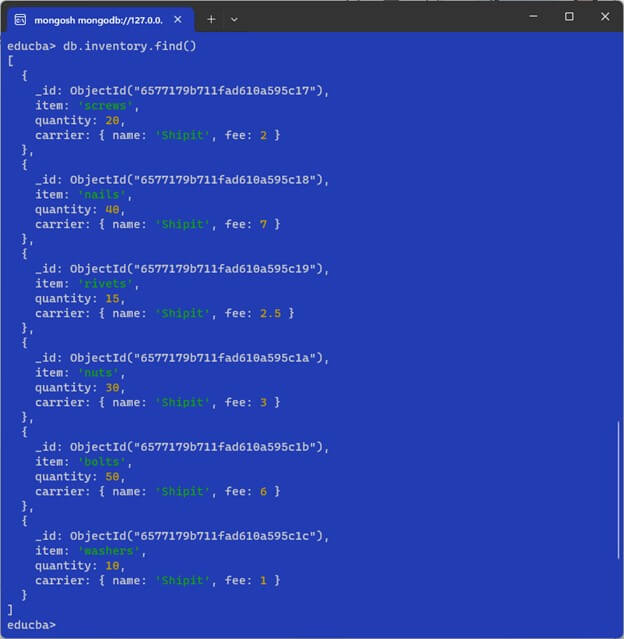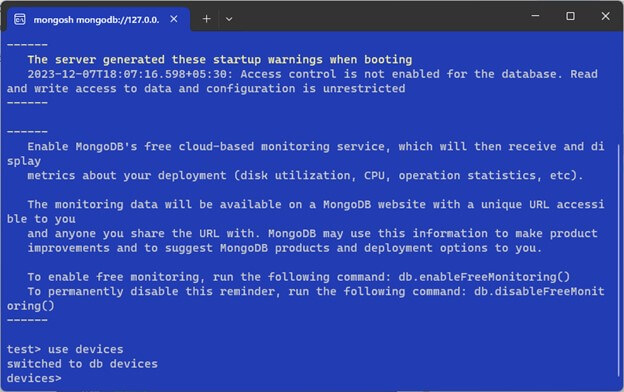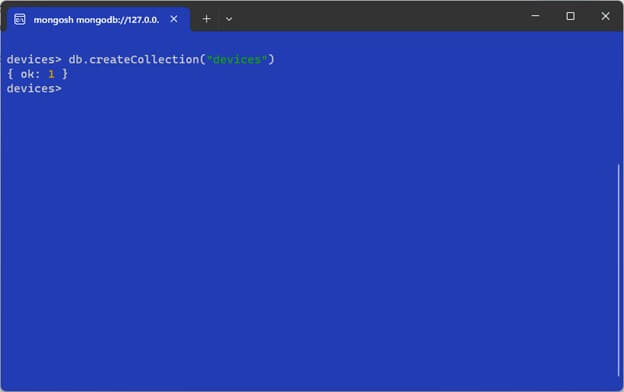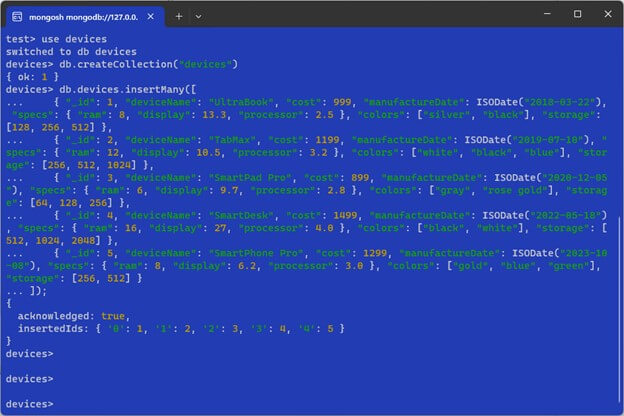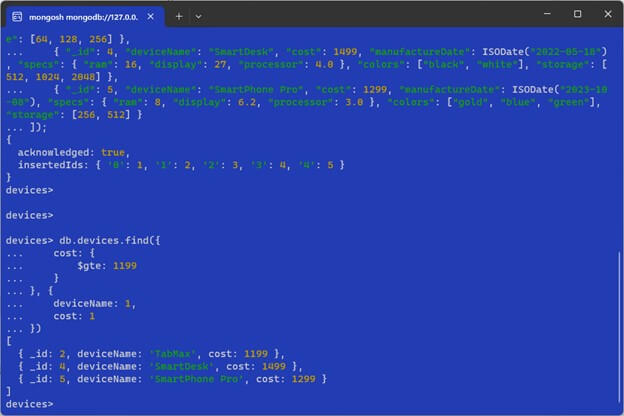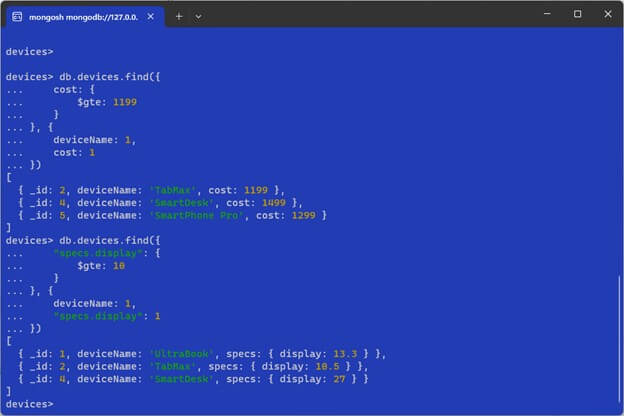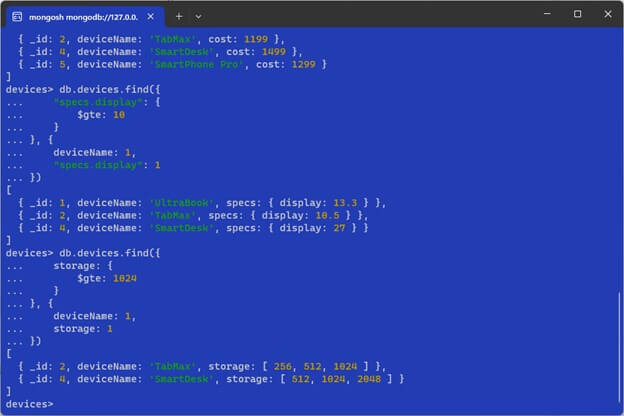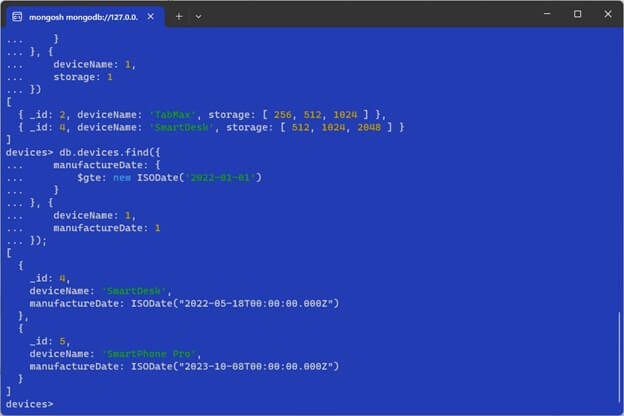Updated December 13, 2023
What is MongoDB $gte Operator?
MongoDB has various operators for comparison. The $gte is a MongoDB operator where you can select values greater than or equal (>=) to a given value in documents. You can use $gte in methods like find(), update(), etc.
Various comparison operators can perform comparisons on fields where the BSON type matches the value of the query. MongoDB provides only limited support for cross-BSON comparison through the backing type.
Table of contents
- What is MongoDB $gte operator?
- Compatibility
- Syntax
- Update based on Embedded Document Fields
- Examples using the $gte operator in MongoDB
Compatibility
$gte is used for deployment hosted in these MongoDB environments:
- Atlas: Cloud-managed MongoDB
- Enterprise: Paid, self-managed MongoDB
- Community: Free, self-managed MongoDB
Syntax
The syntax of this $gte operator is as follows:
{ field: { $gte: value } }Consider this example, where we will use the $lt operator.
We will create an “educba” db in Mongodb in the shell:
Now, we will create an “inventory” collection under the “educba” db:
These will be inserted successfully.
Now, we will insert these values in the “inventory” collection:
db.inventory.insertMany( [
{
"item": "screws", "quantity": 20,
"carrier": { "name": "Shipit", "fee": 2 }
},
{
"item": "nails", "quantity": 40,
"carrier": { "name": "Shipit", "fee": 5 }
},
{
"item": "rivets", "quantity": 15,
"carrier": { "name": "Shipit", "fee": 2.5 }
},
{
"item": "nuts", "quantity": 30,
"carrier": { "name": "Shipit", "fee": 3 }
},
{
"item": "bolts", "quantity": 50,
"carrier": { "name": "Shipit", "fee": 4 }
},
{
"item": "washers", "quantity": 10,
"carrier": { "name": "Shipit", "fee": 1 }
}
] )These will be inserted successfully.
We have added this to collections of MongoDB databases. Now, we will query the following:
db.inventory.find({ "quantity": { "$gte": 30 } })This query finds all values with a quantity greater than or equal to 30. There will be three outputs:
Update based on Embedded Document Fields
You can update based on embedded document fields using the $gte operator.
For example, if you want to increase the fee for carriers whose quantity is greater than or equal to 4. Then you can use the following command:
db.inventory.updateMany(
{ "carrier.fee": { "$gte": 4 } },
{ "$inc": { "carrier.fee": 2 } }
)This query uses the $gte operator to find documents where the fee inside the carrier-embedded document is greater than or equal to 4. Then, the $inc operator increases the cost by 2.
The final documents are after the above update query:
Examples Using $gte Operator in MongoDB
Consider another collection to understand the $gte operator in the given examples.
Using the MongoDB shell, we will create “devices” db:
We will create a collection of “devices” under the “devices” db:
Now, we will insert these values into the “devices” collection:
db.devices.insertMany([
{ "_id": 1, "deviceName": "UltraBook", "cost": 999, "manufactureDate": ISODate("2018-03-22"), "specs": { "ram": 8, "display": 13.3, "processor": 2.5 }, "colors": ["silver", "black"], "storage": [128, 256, 512] },
{ "_id": 2, "deviceName": "TabMax", "cost": 1199, "manufactureDate": ISODate("2019-07-10"), "specs": { "ram": 12, "display": 10.5, "processor": 3.2 }, "colors": ["white", "black", "blue"], "storage": [256, 512, 1024] },
{ "_id": 3, "deviceName": "SmartPad Pro", "cost": 899, "manufactureDate": ISODate("2020-12-05"), "specs": { "ram": 6, "display": 9.7, "processor": 2.8 }, "colors": ["gray", "rose gold"], "storage": [64, 128, 256] },
{ "_id": 4, "deviceName": "SmartDesk", "cost": 1499, "manufactureDate": ISODate("2022-05-18"), "specs": { "ram": 16, "display": 27, "processor": 4.0 }, "colors": ["black", "white"], "storage": [512, 1024, 2048] },
{ "_id": 5, "deviceName": "SmartPhone Pro", "cost": 1299, "manufactureDate": ISODate("2023-10-08"), "specs": { "ram": 8, "display": 6.2, "processor": 3.0 }, "colors": ["gold", "blue", "green"], "storage": [256, 512] }
]);These will be inserted successfully:
This collection has fields: deviceName, cost, manufactureDate, specs, colors, and storage. These documents are used in examples with the $gte operator for the following various queries.
Query 1
Select documents where the cost is greater than or equal to 1199:
db.devices.find({
cost: {
$gte: 1199
}
}, {
deviceName: 1,
cost: 1
})The output will be,
Query 2
Check if the display size in the specs document is greater than or equal to 10:
db.devices.find({
"specs.display": {
$gte: 10
}
}, {
deviceName: 1,
"specs.display": 1
})The output will be,
Query 3
Check if an array element in storage is greater than or equal to 1024:
db.devices.find({
storage: {
$gte: 1024
}
}, {
deviceName: 1,
storage: 1
})The output will be,
Query 4
Select documents where the manufacture date is after or on 2022-01-01:
db.devices.find({
manufactureDate: {
$gte: new ISODate('2022-01-01')
}
}, {
deviceName: 1,
manufactureDate: 1
});The output will be,
Conclusion
The $gte is an operator in MongoDB that selects documents with values greater than or equal (>=) to the given value. You can find and update values by using the $gte operator. MongoDB’s $gte operator efficiently selects and updates documents based on specified criteria.
FAQ’s
Q1. How is the $gte operator similar to other MongoDB comparison operators?
Answer: The $gte in MongoDB is used for comparison. Other comparison operators in the MongoDB include $gt (greater than) and $eq (equal). But note that the $gte (greater than or equal to) operator consists of both this $ gt (greater than) and $eq (equal). This property provides flexibility for various queries and filtering based on multiple values.
Q2. In which MongoDB environments can the $gte operator be deployed?
Answer: The $gte operator can be used in MongoDB environments like Altas (cloud-managed MongoDB), Enterprise(paid and self-managed MongoDB), and community (free and self-managed MongoDB).
Q3. How do you use the $gte operator to update documents based on embedded document fields?
Answers: You can update documents based on embedded document fields using the $gte operator. You can use the updateMany() method. For example, if you want to increase fees for carriers whose quantity is greater than or equal to 30. You can use this command:
db.inventory.updateMany(
{ "carrier.fee": { "$gte": 30 } },
{ "$inc": { "carrier.fee": 2 } }
)This will find documents where the fee inside the carrier-embedded documents is greater than or equal to 30 and then increment the fee by 2.
Q4. Can you use the $gte operator for date-based queries in MongoDB?
Answer: We can use the $gte operator for date-based operator queries. For example, if you want to select documents where the manufacture date is after or on January 1, 2022. You can use this command:
db.devices.find({
manufactureDate: {
$gte: new ISODate('2022-01-01')
}
}, {
deviceName: 1,
manufactureDate: 1
});Recommended Articles
We hope this EDUCBA information on “MongoDB $gte” benefited you. You can view EDUCBA’s recommended articles for more information.

